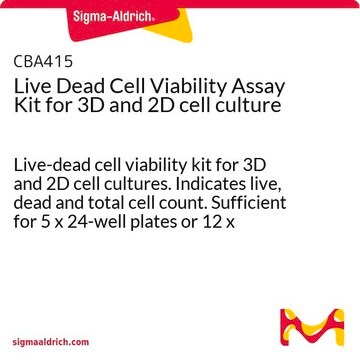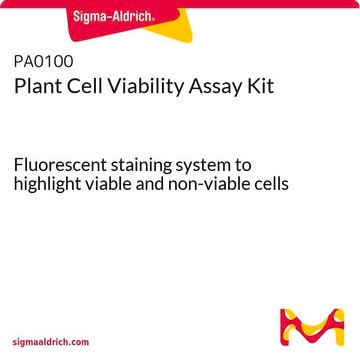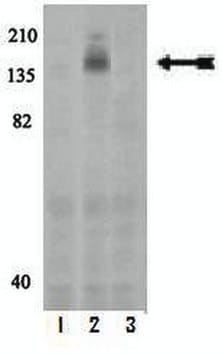This product requires preparation of a cell suspension and has not been validated for bacterial biofilms or cells attached to any surface.
04511
Doppelfärbungs-Kit für lebende/tote Zellen
suitable for fluorescence
Synonym(e):
Färbungskit für lebende/tote Zellen
Größe auswählen
Größe auswählen
About This Item
Empfohlene Produkte
Verwandte Kategorien
Anwendung
Nur Kit-Komponenten
- Solution A (Calcein AM solution) 4 × 50
- Solution B (propidium iodide solution) 300 μL
Ähnliches Produkt
Lagerklassenschlüssel
10 - Combustible liquids
WGK
WGK 2
Flammpunkt (°F)
185.0 °F - closed cup
Flammpunkt (°C)
85 °C - closed cup
Hier finden Sie alle aktuellen Versionen:
Besitzen Sie dieses Produkt bereits?
In der Dokumentenbibliothek finden Sie die Dokumentation zu den Produkten, die Sie kürzlich erworben haben.
Kunden haben sich ebenfalls angesehen
Artikel
Zellbasierte Assays für Zellproliferation (BrdU, MTT, WST1), Zellviabilität und Zytotoxizitätsversuche für Anwendungen in der Krebs- und Stammzellforschung und in den Neurowissenschaften.
Cell based assays for cell proliferation (BrdU, MTT, WST1), cell viability and cytotoxicity experiments for applications in cancer, neuroscience and stem cell research.
-
Can this kit be used to assess cell viability within bacterial biofilms?
1 answer-
Helpful?
-
-
Can the live/dead double staining kit be used on fixed cells?
1 answer-
The kit is not designed for use with just dead cells. When cells are fixed, it typically results in cell death for all cells. Consequently, if all the cells are dead, it is expected that the Calcein AM would not be able to enter the cells, as Calcein AM is not a fluorescent molecule. The available data sheet states, "While the cells are viable, the calcein generated from CalceinAM by esterase in a viable cell emits strong green fluorescence (excitation: 490 nm, emission: 515 nm)." Therefore, Calcein-AM only stains viable cells. If all the cells are dead, the only observed staining will be from the Propidium Iodide - which is the dead cell stain reagent in kit 04511.
If the cells are stained while viable, it is possible to image the cells after they have been fixed in paraformaldehyde or other fixatives. Although this is a common practice in some laboratories, It's suggested to consider a 10-minute fixation instead of 30 minutes, as fixing for 30 minutes may not be advisable.Helpful?
-
-
How many assays or tests can be conducted using one kit of PN: 04511-1KT-F?
1 answer-
The 04511 kit consists of 2 components, with reagent B being the limiting reagent, requiring just 300 microliters of reagent. To prepare the staining solution, 10 microliters of Reagent A and 5 microliters of Reagent B are mixed with 5 ml of PBS. Each test necessitates 100 microliters of the staining solution. With 5 microliters of Reagent B being sufficient for 50 tests, 300 microliters of Reagent B is adequate for 60 batches of the staining reagent, resulting in 3000 tests (50 x 60). Although the maximum number of specimens might not always be stained in practice, the kit theoretically should allow for 3000 tests.
Helpful?
-
Active Filters
Unser Team von Wissenschaftlern verfügt über Erfahrung in allen Forschungsbereichen einschließlich Life Science, Materialwissenschaften, chemischer Synthese, Chromatographie, Analytik und vielen mehr..
Setzen Sie sich mit dem technischen Dienst in Verbindung.










